By Joel DeJong and Rebecca Vittetoe
Parts of the state are classified as being abnormally dry to being in an extreme drought based on the most recent U.S. Drought Monitor map. With the hot temperatures returning this week and little to no rainfall in the forecast, there are concerns about what this might mean for corn and soybean crops and other issues we could start to see in fields as a result.
Impact on Crops
Corn - Leaf rolling is the corn’s way of telling us it is experiencing drought stress. Additionally, the corn may also have more of a greyish appearance under more severe drought conditions. When corn plants experience drought stress, they will close their stomates to conserve moisture. Consequently, this also reduces the plants’ ability to perform photosynthesis and it can result in yield loss (Table 1).
Table 1. Example corn yield loss estimates when stress occurs for four or more consecutive days. Adapted from Classen and Shaw, 1970; Rhoads and Bennet, 1990; and Shaw, 1988.
Corn Development Stage | Estimated Yield Loss per Day of Stress |
Early vegetative (VE - V12) | 1 – 3 |
Late vegetative (V12 to VT) | 2 – 5 |
Pollination to Blister (R2) | 3 – 9 |
Milk (R3) | 3 – 6 |
Dough (R4) | 3 – 5 |
Dent (R5) | 2 – 4 |
Maturity (R6) | 0 |
It wouldn’t be surprising to see some tip back on ears due to the plant having to abort some kernels. We see the kernels near the tip get aborted first since they are typically the last to be fertilized and are less vigorous. Aborted kernels will look more shrunken and mostly white in appearance, and you may see a yellow embryo inside. Unpollinated ovules will appear as blank areas on the ear. The first two weeks right after pollination is when we are most likely to see kernel abortion. After that, yield loss is more due to a reduction in dry weight accumulation in the kernels.
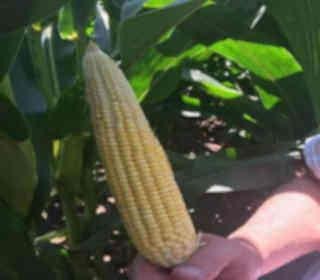
Tipping back on a corn ear due to drought stress. Photo courtesy of Rebecca Vittetoe.
Soybeans – Soybeans respond to drought stress by flipping their leaves over to conserve moisture. Soybeans may also abort flowers or pods as well. Examine the base of the soybean plants to see if the lower leaves are drying out and dying. Lower pods will also dry out and will fall off when short of moisture or can easily fall of when touched. Plants shed these lower leaves and pods to protect the upper leaves and flowers. Thankfully soybeans are more forgiving and if conditions improve, they can put on new flowers and pods. However, we see less compensation from soybeans once we reach R4 stage. Additionally, drought stress can also result in fewer seeds per pod and smaller seed size.
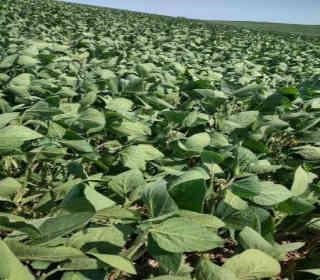
Soybean field with the leaves flipped over. Photo courtesy of Joel DeJong.
Other issues
Spider Mites – There have already been scattered reports of spider mites in the drier areas in Iowa in both corn and soybeans. Spider mite activity increases when we have temperatures above 85F, humidity less than 90 percent, and low moisture levels. Usually, they start feeding on the bottom of the plant and work their way up. Symptoms of spider mite injury are small yellow dots or stipples on the leaves. Eventually the leaves will die and fall off the plant. You may also notice webbing on the underside of the leaves. Read more about scouting for spider mites and the thresholds for treating here.
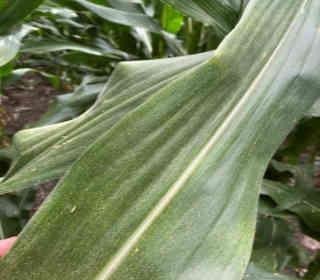
Stippling on a corn leaf due to spider mites. Photo courtesy of Rebecca Vittetoe.
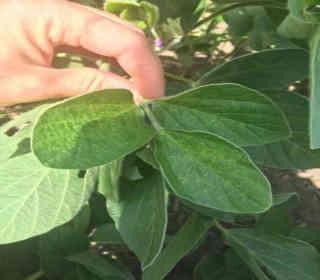
Soybean leaf showing stippling due to spider mites. Photo courtesy of Rebecca Vittetoe.
Potassium Deficiency – It’s not uncommon to see potassium deficiency show-up in corn and soybean fields under dry conditions. This doesn’t mean that the soil doesn’t have enough potassium, but rather not enough moisture available for the potassium that is there to be in solution for the plant to take up.
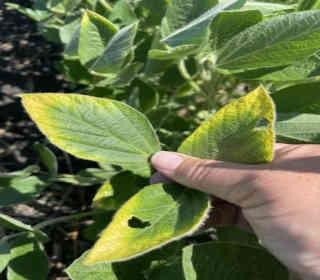
Potassium deficiency on a soybean plant. Photo courtesy of Angie Rieck-Hinz.
Source : iastate.edu